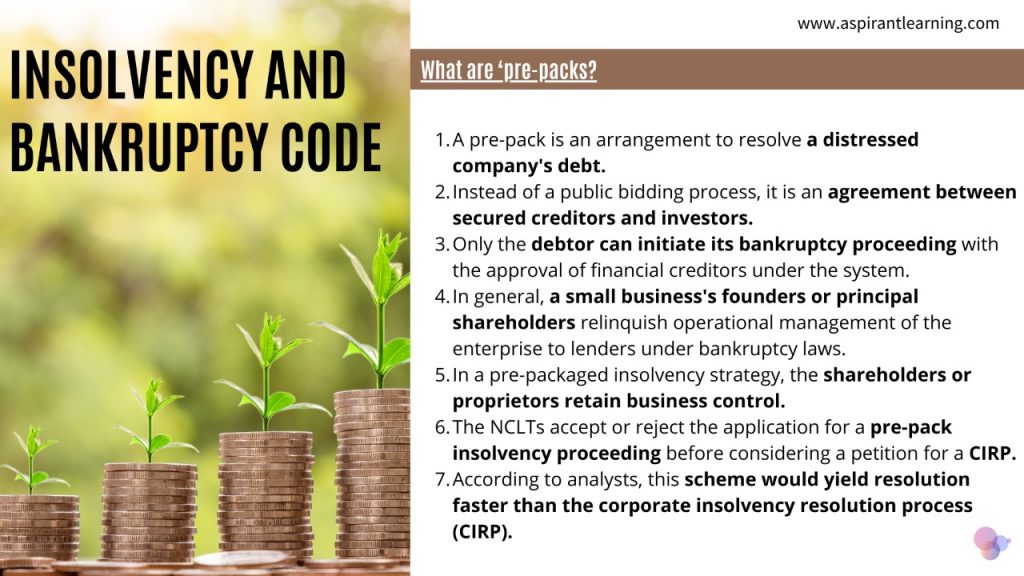News Highlight
The seven-year-old Insolvency and Bankruptcy Code was enacted when over-leveraged companies weighed down India’s banks.
Key Takeaway
- India has proposed over 40 amendments to its insolvency law.
- It might alter how recoveries are distributed among creditors, decriminalise commercial failures, permit the dissolution of empires, and grant the government extra authority in situations of public interest.
- The law had some early success, but litigation delays and pandemic interruptions damaged it.
Insolvency and Bankruptcy Code (IBC)
- About
- Firstly, insolvency occurs when people or businesses cannot fulfil their debts.
- In 2016, the Insolvency and Bankruptcy Code (IBC) was enacted in response to growing non-performing loans.
- In addition, to reform India’s business distress resolution process.
- To integrate current legislation to create a time-bound process based on a creditor-in-control model instead of a debtor-in-possession one.
- Objectives
- All existing insolvency laws in India should be centralised and amended.
- To expedite and explain India’s insolvency and bankruptcy proceedings.
- To protect the firm’s stakeholders/debtors/creditors/employees’ interests.
- Encourage entrepreneurship while also renewing the organisation promptly.
- In India, an insolvency and bankruptcy board will be established.
- Furthermore, to offer critical relief to creditors, thereby enhancing the economy’s credit supply.
Challenges of Insolvency and Bankruptcy Code
- Lack of proper resolution
- According to IBBI data from 3400 instances over the last six years, more than half of the cases ended in liquidation, with only 14% finding a proper conclusion.
- Significant resolution delays
- IBC was initially marketed as a time-bound method.
- The modified IBC act reduced the time required to complete the resolution procedure from 180 days to 330 days.
- Lack of digitisation
- Due to the lack of digitalisation, the insolvency resolution procedure has been delayed beyond the statutory limits.
Insolvency and Bankruptcy Code (Amendment)bill, 2021
- About
- The Bankruptcy and Bankruptcy Code (Amendment) Bill, 2021, was tabled in the Lok Sabha to change insolvency law and create a prepackaged resolution procedure for stressed Micro, Small, and Medium Enterprises.
- Additionally, it recommended ‘pre-packs‘ to resolve insolvency for MSMEs.
- Instead of a public bidding process, this mechanism brings key stakeholders such as creditors and shareholders to discover and negotiate with a prospective purchase.
- Provisions of the Bill
- It provides a Rs 1 crore minimum threshold for commencing the pre-packaged insolvency resolution process.
- It allows for determining concurrent petitions for initiating the bankruptcy resolution process and pre-packaged insolvency resolution processes filed against the same corporate debtor.
- Penalty for initiating a pre-packaged insolvency resolution process fraudulently or maliciously with the intent to defraud persons, as well as for fraudulent management of the corporate debtor during the process.
- Furthermore, penalty for offences involving the pre-packaged insolvency resolution process.

Way Forward
- The Parliamentary Standing Committee proposed a schedule of no more than 30 days from filing to admit the insolvency application and transfer management of the company to a resolution procedure.
- A new yardstick for measuring hairstyles: Haircuts, according to the IBBI, should not be viewed as the difference between the creditor’s claims and the actual amount realised.
- Budgetary allocations that are optimal for upskilling insolvency practitioners, enhancing tribunal infrastructure, and digitising the insolvency resolution process.
Pic Courtesy: Deccan Herald
Content Source: Deccan Herald



